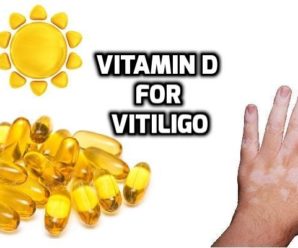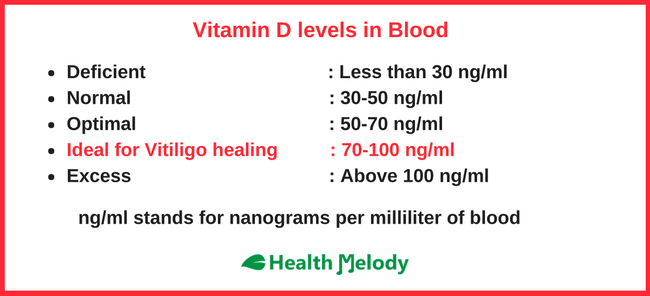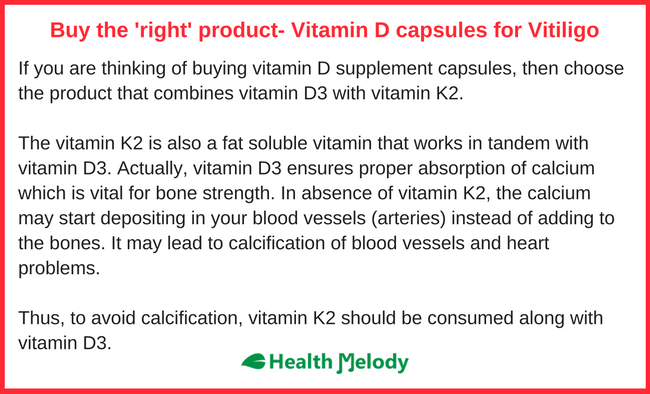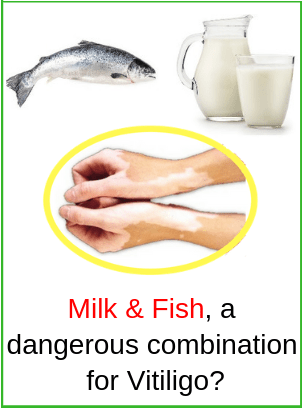
Does Vitamin D help with Vitiligo
In many cases, people do not get expected relief in their vitiligo symptoms even after following all the rules of a healthy diet and positive lifestyle. The reason may be very low levels of Vitamin D. Here, we are talking about Vitamin D3; the same Vitamin which our body can synthesize from the Sunlight.
Optimal level of Vitamin D in your blood can help control your vitiligo symptoms when combined with a healthy diet, positive lifestyle and intelligent use of natural herbs and dietary supplements. However, Vitamin D should not be taken as a ‘miracle cure’ for vitiligo as there is no known cure for vitiligo available.
What is Vitamin D
Vitamin D is a fat soluble vitamin; an essential nutrient that is required for optimum bone strength, heart health and immune system. There are research evidences to establish Vitamin D’s role in cancer prevention also. (1, 2) Deficiency of Vitamin D can lead to mood swings, depression, anxiety and fatigue as well.
Vitamin D, also known as cholecalciferol, needs to be converted into calcitriol through the body metabolism. The calcitriol is the real nutrient- it is the biologically active form of Vitamin D that provides all the health benefits related to Vitamin D. It acts like a hormone and helps regulate body’s physiology.
The hormones are chemical messengers that travel through the blood to various organs activating chemical reactions that control the whole body physiology-metabolism, growth, development, mood and just everything.
Our body can get Vitamin D by below 3 ways:
- Exposure to sun– Vitamin D is also known as ‘sunshine vitamin’ because sunlight can provide 80-85% of the daily requirement of Vitamin D. The human body synthesizes Vitamin D with the UV B rays of the sunlight.
- Food sources– Unfortunately, food sources never make a reliable source of vitamin. Apart from some varieties of oily fish and milk, you wouldn’t find any naturally rich source of Vitamin D.
- Dietary supplements (Vitamin D capsules) – In case of Vitamin d deficiency in your body, consuming Vitamin D capsules is the quickest and easiest way to maintain optimal Vitamin D levels.
Vitiligo is an Autoimmune skin condition
Vitiligo refers to skin de-pigmentation problem that occurs due to an autoimmune response. The immune system becomes faulty, confused and mistakenly attacks the pigment producing healthy skin cells called as melanocytes. It results in damage (or destruction) of melanocytes and localized skin de-pigmentation in the form of white patches.
The various possible reasons for this autoimmune response are chronic stress, poor gut health, faulty genes, infections (such as strep throat), skin injury, overuse of antibiotics and steroids, alcohol over consumption and poor diet and lifestyle habits.
In natural (holistic) healing concept, ‘leaky gut’ is taken as the root cause of all autoimmune problems including vitiligo. The leaky gut means leakage in the gut. The gut is your whole gastro-intestinal tract from the mouth to the anus. When you eat food, it travels from mouth, food pipe, stomach to reach the small intestine. The lining (wall) of your small intestine has a net like porous structure so that the micro nutrients can pass through and enter the blood stream. Due to the reasons listed above, this delicate net structure gets damaged and the holes become bigger so that the toxins such as undigested food particles, disease causing microbes, heavy metals and other waste materials seep through and get mixed with your blood. The immune system considers these unwanted foreign matters as harmful and triggers an autoimmune response in the form of skin de-pigmentation. Thus, vitiligo, being an autoimmune skin issue, begins in your gut and its healing process also lies in the gut itself.
How Vitamin D can help in Vitiligo
Role of Vitamin D in healing autoimmune diseases cannot be over emphasized. There are research evidences available that adequate amount of Vitamin D can help treat a variety of autoimmune issues that include vitiligo, eczema, psoriasis, scleroderma, rheumatoid arthritis, multiple sclerosis, lupus and type 1 diabetes. (3, 4, 5, 6, 7)
- The cells of your immune system have Vitamin D receptors. The calcitriol attaches to these receptors and stimulate protein synthesis which regulate the way immune system works. A regulated, controlled immune system means reduced autoimmune response and hence, better vitiligo management.
- T cells, a type of white blood cells, play a key role in the immune system response to fight off disease causing foreign matters like fungi, bacteria and viruses. In case of autoimmune problems, these t cells get imbalanced, stressed and over reacts that results in autoimmune response- attacking body’s own cells. Vitamin D can help here by regulating the t cells. It makes your immune system smarter so that it can differentiate between body’s own cells and foreign invaders.
- Vitamin D has hormone activity and it regulates more than 1000 genes in your body and many of them are involved in the functioning of the immune system.
- Vitamin D reduces inflammation in the gut
- Vitamin D is research proven to repair the leaky gut by improving the structural integrity of the gut lining (wall). It helps maintain the gut barrier function. (8, 9)
Read more: Turmeric (curcumin) benefits for Vitiligo
Vitamin D deficiency among people with vitiligo
Dr Joseph Georghy, a Sydney based cosmetic surgeon says that almost all of his patients with vitiligo has been found to be deficient in vitamin D. Vitamin D plays a crucial role in normal immune system. Thus, addressing the vitamin D deficiency along with tacking stress can greatly help in better vitiligo management.
Vitamin D deficiency is one of the most common deficiencies among the people around the world. (10) When it comes to autoimmune problems, the deficiency is even more alarming. (11, 12, 13, 14)
In case of vitiligo, the deficiency of Vitamin D is highly prevalent for below obvious reasons:
- Less exposure to Sun rays– In today’s hectic modern lifestyle, we hardly get time to spend outside in the sunlight. Mostly we remain indoors. Moreover, many people use sunscreens to shield the skin against sun rays. The air pollution also restricts direct exposure of your skin to the sunlight. Your location also matters a lot. If you live in a part of the world with less sun exposure during certain seasons of the year, then your exposure to sunlight further shrinks. In case of vitiligo, many people feel burning sensation due to sunlight and hence, getting some extra Vitamin d from sunlight is not possible for them.
- Limited food sources– You can never get enough Vitamin D through the diet. As explained above, food sources contribute hardly 10-15% of the total Vitamin D requirement for the human body. The list of food sources with Vitamin D is: Milk, orange juice, some cereals, Egg yolk, mushroom, fish (cod) liver oil and oily varieties of fish like salmon, tuna, trout, swordfish etc. Moreover, most of these foods are not ‘naturally’ rich in Vitamin D. That’s why you would find packets of milk, orange juice and breakfast cereals labelled as ‘fortified with Vitamin d’. It means that Vitamin D is added in these food packets to meet the daily nutrition requirements. In case of vitiligo, milk, eggs, mushroom and cereals (gluten) are advised to be consumed in small amounts only. Hence, food sources would never be a reliable source of Vitamin D for the people with vitiligo.
Read more: Eggs and Vitiligo – To eat or not to eat
- Fat malabsorption– To properly absorb a fat soluble nutrient like Vitamin D, your gut should be healthy enough to digest (absorb) fats from your diet. Vitiligo is often linked to a compromised gut health and poor digestive health. It severely reduces the body’s ability to absorb Vitamin D from your diet.
- Poor liver health– As explained earlier, the biologically active form of Vitamin D, calcitriol, is produced through body metabolism and liver plays a vital role in it. In case of vitiligo, the liver health is under the scanner as well because autoimmune disorders are often linked to a poor liver health. Hence, there are high chances that a less efficient liver would make it difficult to get enough of the calcitriol.
Thus, it is quite logical to say that most of the people with vitiligo will have Vitamin D deficiency in their bodies.
How to test the Vitamin D deficiency?
Just go to any pathological laboratory (medical testing facility) and get tested for the Vitamin D levels in your blood.
The test name is 25-hydroxy Vitamin D test. Also, known as 25-(OH) Vitamin d test.
Below table would help you understand the test results:

How much Vitamin D per day you need?
The ideal range of Vitamin D in blood to manage vitiligo is 70-100 ng/ml. In case of deficiency, you would need Vitamin D supplement capsules to attain this level.
Now, the next question is- exactly how much Vitamin D per day is required in your case?
Well, it would depend upon your existing levels.
In case of moderate deficiency, 5000 IU (International Units) of Vitamin D per day can be taken until you reach the ideal level. For severe deficiency, you can take up to 10000 IU per day as advised by your physician. For children, 2000 IU per day would work.
Never consume more than 5000 IU per day of Vitamin D without a doctor’s consultation.
If you worried about overdose, then let me tell you that the upper safety limit of Vitamin D for healthy adults is 4000 IU per day and for children, it ranges between 1000 IU to 3000 IU depending upon the age. (15) Hence, 5000 IU per day in case of deficiency is quite a justified dosage.
“A clinical trial performed by the Brazilian researchers observed that 35000 IU of Vitamin D per day for a period of 6 months brought 25-75% re-pigmentation among 14 out of 16 vitiligo patients. (3) However, I recommend never to go beyond 5000 IU /day without doctor’s consultation.”
How long to consume Vitamin D capsules
Well, it will depend upon the level of deficiency and the dosage.
For instance, if your existing Vitamin D level is 30-40 ng/ml, then 5000 IU per day for 3 months should make it above 70 ng/ml in 3 months.
If your existing Vitamin D level is less than 30 ng/ml, then it would more time with the same dosage of 5000 IU per day.

From where to buy
Buy the right product (Vitamin D3 + Vitamin K2) of a reputed brand from a store near to you or check below Amazon links for my recommendations. I have selected these products on the basis of product description, brand value and consumer reviews:
| USA readers | India readers | UK readers | |
|---|---|---|---|
| Vitamin D3 5000 IU (plus Vitamin K2) | Click here | Click here | Click here |
| Vitamin D3 2000 IU (plus Vitamin K2) | Click here | Click here | Click here |
When you start consuming Vitamin D supplement capsules, it is advised to get your blood levels checked every 2-3 months to have an idea if you need further supplementing or not.
Try to get some sun exposure also
Apart from consuming Vitamin D capsules, try to get some sunlight exposure as well (if your skin allows).
Ideal conditions for sunbathing is during the middle of the day, 10 am to 2 pm, when UV B rays are most prominent. Sunbathing for 10 to 20 minutes, 2 to 3 times a week would be sufficient.
For light (white) skinned adults, 10 to 15 minutes sun exposure is enough. For dark skinned ones, you need more exposure time- 20 minutes or more. Same is the case for elderly people because the process of Vitamin D synthesis gets slow down with age.
Vitamin D creams for external application on Vitiligo patches
Many people ask if applying vitamin D creams on vitiligo lesions would help. Well, I don’t feel too optimistic about this idea. Vitiligo is an autoimmune skin condition and more than 70% of the immune system lies in your gut. Thus, the real, long term healing of vitiligo will be possible only if you address the internal body matters and improve your gut health. Any kind of external treatment such as cream or oil would not provide much relief.
If you are really interested, then you may try creams which contain biologically active form of vitamin D. These creams contain synthetic derivatives of calcitriol with the names of calcipotriol (or calcipotriene) and tacalcitol.
Many clinical trials have been performed to study the combined effect of vitamin D creams along with UV light therapy, but, observed varying results. Thus, more bulk trials are required to determine if vitamin D creams are effective for vitiligo. (16, 17, 18, 19)
Read more: Does Vitamin D cream help with Vitiligo



